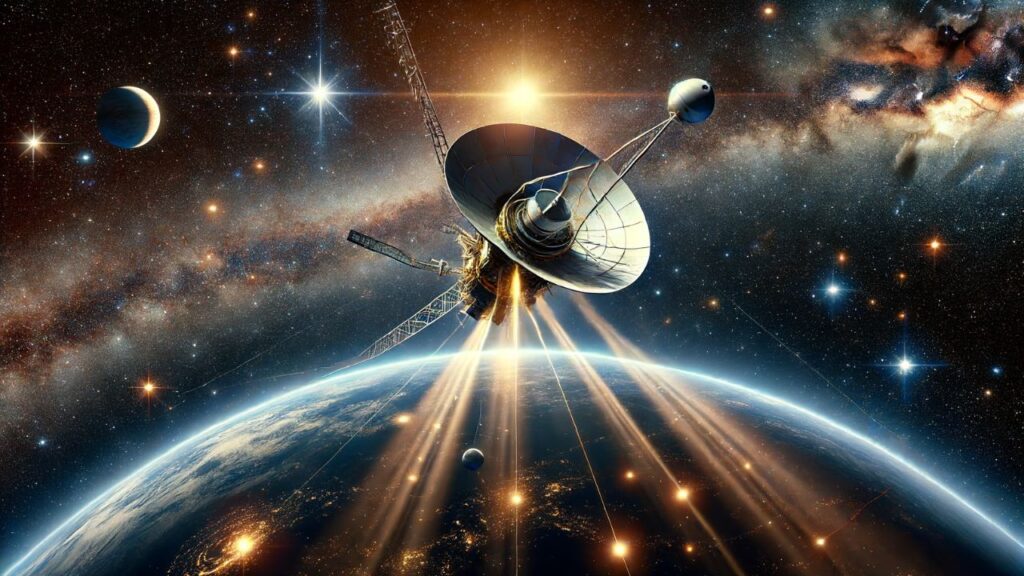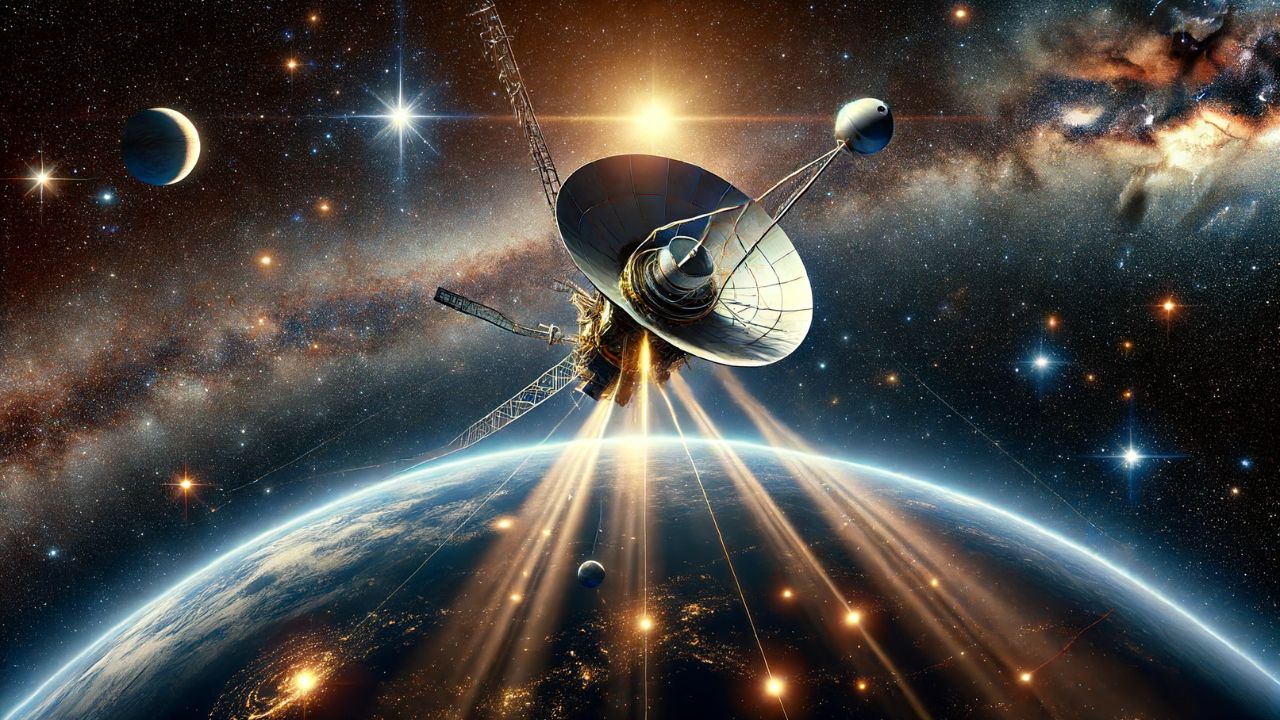NASA Voyager 1, NASA Voyager, Voyager 1 science operations, interstellar space exploration, Voyager 1 instruments, NASA space missions, Voyager 1 gyroscope issue, Voyager 1 data, Voyager spacecraft, deep space missions
“NASA’s Voyager 1 has successfully resumed science operations after overcoming a technical issue. Learn about the spacecraft’s continued exploration of interstellar space, the instruments collecting valuable data, and the legacy of the Voyager mission.

Voyager 1: Resuming Science Operations and Exploring Interstellar Space
NASA’s Voyager 1 spacecraft has once again begun conducting normal science operations, successfully overcoming a technical issue that emerged in November 2023. This remarkable achievement underscores the resilience and enduring capabilities of the Voyager mission, which continues to provide invaluable data about interstellar space.
The Technical Issue and Its Resolution
In November 2023, Voyager 1 encountered a technical problem that temporarily halted its science operations. This issue was a significant concern for the mission team, as Voyager 1 is one of only two spacecraft that have ventured beyond the heliosphere, the protective bubble of magnetic fields and solar wind created by the Sun. The spacecraft’s ability to gather data about interstellar space is crucial for advancing our understanding of this largely unexplored region.
Initial Steps to Recovery
The mission team made significant progress in addressing the problem in April 2024. By prompting Voyager 1 to return engineering data, they were able to gather critical information about the health and status of the spacecraft. This data provided insights into the nature of the technical issue and guided the team’s subsequent actions.
Full Restoration of Science Operations
On May 19, 2024, the mission team took the decisive step of beaming a command to Voyager 1 to resume returning science data. This command was successfully executed, and two of the four science instruments on the spacecraft immediately returned to their normal operating modes. The remaining two instruments required additional adjustments, but they too eventually began returning usable science data. As a result, all four instruments are now fully operational, allowing Voyager 1 to continue its scientific mission.
The Scientific Instruments and Their Significance
Voyager 1 is equipped with four key science instruments that study plasma waves, magnetic fields, and particles. These instruments are vital for understanding the properties of interstellar space. The data they collect helps scientists explore the behavior of plasma waves, the structure and dynamics of magnetic fields, and the distribution and characteristics of particles in this distant region.
Plasma Wave Science Instrument
The plasma wave science instrument is particularly important, as it provides direct measurements of the density and temperature of the plasma environment in interstellar space. This instrument’s data is recorded on a digital tape recorder and transmitted to Earth twice per year. The maintenance of this recorder is one of the tasks the mission team is focusing on to ensure the continuous flow of valuable data.
Magnetic Field and Particle Instruments
The instruments that measure magnetic fields and particles complement the plasma wave data by providing insights into the interactions between the solar wind and the interstellar medium. These measurements help scientists understand the processes that shape the boundary regions of the heliosphere and the broader interstellar environment.
Challenges of Operating a Distant Spacecraft
Operating Voyager 1, which is now more than 15 billion miles (24 billion kilometers) from Earth, presents unique challenges. Communication with the spacecraft requires significant time, with signals taking over 21 hours to travel each way. This delay necessitates careful planning and precise execution of commands.
Resynchronizing Onboard Computers
One of the tasks the mission team must undertake is resynchronizing the timekeeping software in Voyager 1’s three onboard computers. This synchronization is crucial for ensuring that commands are executed at the correct times, maintaining the smooth operation of the spacecraft.
Ongoing Maintenance and Monitoring
In addition to resynchronizing the computers, the team will perform maintenance on various systems, including the digital tape recorder. This proactive approach is essential for addressing any potential issues before they can impact the spacecraft’s ability to collect and transmit data.
The Legacy of the Voyager Mission
Voyager 1 and its twin, Voyager 2, were launched in 1977 with the primary mission of exploring the outer planets of our solar system. Both spacecraft provided unprecedented close-up images and data of Jupiter and Saturn, while Voyager 2 also flew past Uranus and Neptune. These missions greatly expanded our knowledge of these distant worlds and their moons.
Venturing Beyond the Heliosphere
After completing their primary mission, the Voyager spacecraft continued their journey, eventually crossing the heliopause — the boundary where the solar wind meets the interstellar medium. Voyager 1 crossed this boundary in 2012, becoming the first human-made object to enter interstellar space. Voyager 2 followed in 2018, providing a second set of data to compare and enhance our understanding of this transition region.
Continued Contributions to Science
Even after 47 years of operations, the Voyager spacecraft continue to contribute to science. Their observations of interstellar space provide unique insights that cannot be obtained from any other source. The data collected by Voyager 1 and Voyager 2 help scientists study the fundamental properties of the interstellar medium, the behavior of cosmic rays, and the influence of the heliosphere on its surroundings.
The Future of the Voyager Mission
NASA anticipates that the Voyager spacecraft will continue to make scientific discoveries for years to come. Despite the challenges posed by their vast distance from Earth and aging hardware, both Voyager 1 and Voyager 2 remain functional and capable of returning valuable data.
Collaborations with Other Observatories
The continued operation of the Voyager spacecraft complements the work of other observatories, such as the Hubble Space Telescope and the James Webb Space Telescope. Together, these missions provide a comprehensive view of the universe, from the nearest regions of our solar system to the most distant galaxies.
Inspiring Future Generations
The Voyager mission has inspired generations of scientists, engineers, and the public. Its success demonstrates the power of human ingenuity and the potential for exploration beyond our planet. As we continue to push the boundaries of space exploration, the lessons learned from Voyager will guide future missions and inspire new achievements.
Conclusion
The successful resumption of normal science operations by NASA’s Voyager 1 spacecraft is a testament to the dedication and expertise of the mission team. By overcoming technical challenges and ensuring the continued collection of valuable data, Voyager 1 remains a vital tool for exploring the mysteries of interstellar space. As the spacecraft continues its journey, it will undoubtedly contribute to new scientific discoveries, enhancing our understanding of the universe and inspiring future generations to reach for the stars.
Read More
- Boeing and NASA Proceed with Starliner Launch Despite Helium Leak
- NASA PREFIRE Mission: Tiny Satellites Measuring Earth’s Polar Heat Loss
- NASA Milestone Spacewalk 90: A Leap Forward in Space Exploration
- Boeing and NASA Proceed with Starliner Launch Despite Helium Leak










